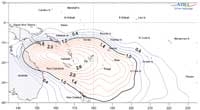
Tropical cyclone risk across the South Pacific, 2008–09
Jim Salinger and James Renwick, NIWA
Neutral El Niño/Southern Oscillation (ENSO) conditions are likely to produce average tropical cyclone activity for most tropical South Pacific countries over the coming months. Communities should remain alert and prepared.
In the South Pacific, tropical cyclones usually develop in the wet season, from November through to April, but occasionally occur in October and May. Peak cyclone occurrence is usually from January to March. In seasons with similar climate backgrounds, several tropical cyclones usually occur in the region between Vanuatu, New Caledonia, Fiji, and Tonga, while a few affect other areas. In an average season about half of the tropical cyclones that develop reach hurricane force with mean wind speeds of at least 64 knots (118 km/h).
For the coming tropical cyclone season, from November 2008 – May 2009, we are likely to see a normal risk of occurrence over much of the South Pacific. A reduced risk of tropical cyclones is likely in parts of French Polynesia east of the Date Line. Climate forecasting organisations in the Pacific are in general agreement that neutral ENSO conditions are likely to persist from spring into summer in the Southern Hemisphere. As a result, the likelihood is for a normal risk of tropical cyclones. There is a good chance that the first tropical cyclone of the coming season in the South Pacific region may occur before the end of December, which is normal during neutral seasons. On average eight to ten tropical cyclones can be expected over the entire South Pacific region during a neutral ENSO season.
South Pacific tropical cyclones are grouped into classes ranging from 1 to 5, with 5 being the most dangerous. In an average season, four are likely to reach class 4 with mean wind speeds of at least 64 knots or 118 km/h, and one to two, class5, with mean speeds in excess of 90 knots or 167 km/h.
| Area | Average over all years | Average over neutral - weak La Niña seasons | Comment |
|---|---|---|---|
| Vanuatu | 3.0 | 2.8 | Average risk |
| New Caledonia | 2.6 | 2.7 | Average risk |
| Fiji | 2.4 | 2.5 | Average risk |
| Tonga | 2.0 | 2.1 | Average risk |
| Wallis & Futuna | 1.9 | 1.8 | Average risk |
| Niue | 1.8 | 1.8 | Average risk |
| Southern Cook Islands | 1.5 | 1.3 | Average risk |
| Tuvalu | 1.2 | 1.1 | Average risk |
| Northen New Zealand | 0.9 | 1.0 | Average risk |
| Tokelau | 0.8 | 0.6 | Average risk |
| Society Islands/ Tahiti | 0.8 | 0.6 | Average risk |
| Samoa | 1.6 | 1.3 | Risk is uncertain |
| Solomon Islands | 1.4 | 1.0 | Average risk |
| Austral Islands | 0.8 | 0.5 | Average risk |
| Northern Cook Islands | 0.8 | 0.4 | Reduced risk |
| Tuamotu Islands | 0.4 | 0.1 | Reduced risk |
| Tuvalu | 1.2 | 0.8 | Reduced risk |
| Pitcairn Islands | 0.3 | 0.1 | Cyclones unlikely |
| Marquesas Islands | 0.1 | 0.0 | Cyclones unlikely |
| Western Kiribati | 0.0 | 0.0 | Cyclones unlikely |
| Eastern Kiribati | 0.0 | 0.0 | Cyclones unlikely |
The average number of tropical cyclones passing within 5º of the main South Pacific island groups between November and May.
In the Pacific islands – contact your local Meteorological Service formore information. This tropical cyclone information has been preparedas a collaborative effort between NIWA and Meteorological Servicesaround the Pacific. It has been prepared based on contributions andclimate information received from the Meteorological Services of Australia(Bureau of Meteorology), Cook Islands, Fiji, French Polynesia, Kiribati,New Caledonia, Niue, Papua New Guinea, New Zealand (MeteorologicalService of NZ), Samoa, Solomon Islands Tonga, Tuvalu, Vanuatu and in theUnited States National Oceanic and Atmospheric Administration (NOAA)and the International Research Institute for Climate and Society (IRI).
